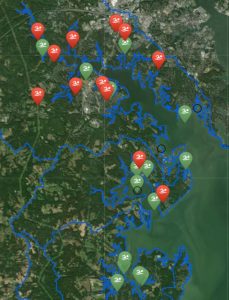November 5, 2019
River Reflections and Underwater Grasses
As we reflect on the past two monitoring seasons, we see a feast-or-famine paradigm unfolding in terms of rainfall and water quality. In 2018, we had record-setting rainfall that brought with it record-setting volumes of dirty stormwater, and the attendant drop in water quality in our rivers. In 2019, we finished out the monitoring season with the second driest September on record, and water quality improved considerably as a result. Clarity improved and our underwater grasses have returned after a 2-year absence. Bacteria levels improved dramatically compared to 2018. Perhaps most significantly for our oyster population, normal salinity levels returned.
Water clarity and underwater grasses go hand-in-hand, as the grasses need clear water to get the sunlight needed for photosynthesis. In 2017 and 2018, the South River didn’t get that clarity, and the perennial beds of widgeon grass disappeared as a result. The drought in 2019 enabled the clear water necessary for underwater grass proliferation, and it did not disappoint, as can be seen in this video taken from above Glebe Bay, right next to our Turnbull Estates living shoreline project.

Our swimming beaches also benefited from the September drought. In 2019, across 12 swimming areas and 16 sampling days, bacteria levels did not meet safe swimming limits 15% of the time. Compare this to 2018, when that level was 30%. Over on the West and Rhode rivers, in addition to an uptick in general bacteria levels, we are expanding our collaboration with Smithsonian Environmental Research Center (SERC) who will perform DNA testing this winter on bacteria found at Holly Hill Harbor and Rockhold Creek, to determine conclusively whether bacteria is coming from human or animal sources. Check out the summer Bacteria readings near you on our data map https://www.southriverdata.net.
Finally, the lack of rain has allowed the salinity levels in the rivers to return to levels which are far more encouraging of oyster growth and reproduction. Last year we saw salinity on the Glebe Bay oyster reef consistently below 5 parts per thousand, at the absolute lower end of what oysters can tolerate, and it is unlikely that any larvae survived. The National Oceanic and Atmospheric Administration informs us that oyster larvae need 10-27 ppt water, and adults can tolerate salinity from 5-40 ppt, but optimum range is 14-28 ppt. By September this year, salinity had finally crept up above 10 ppt, and has stayed there since, inside the river’s historical salinity range.
All told, the drought in 2019, while tough on terrestrial plants, was just the sort of weather the rivers needed to bounce back from the onslaught of rain in 2018. Here’s hoping some balance returns to the weather in 2020.